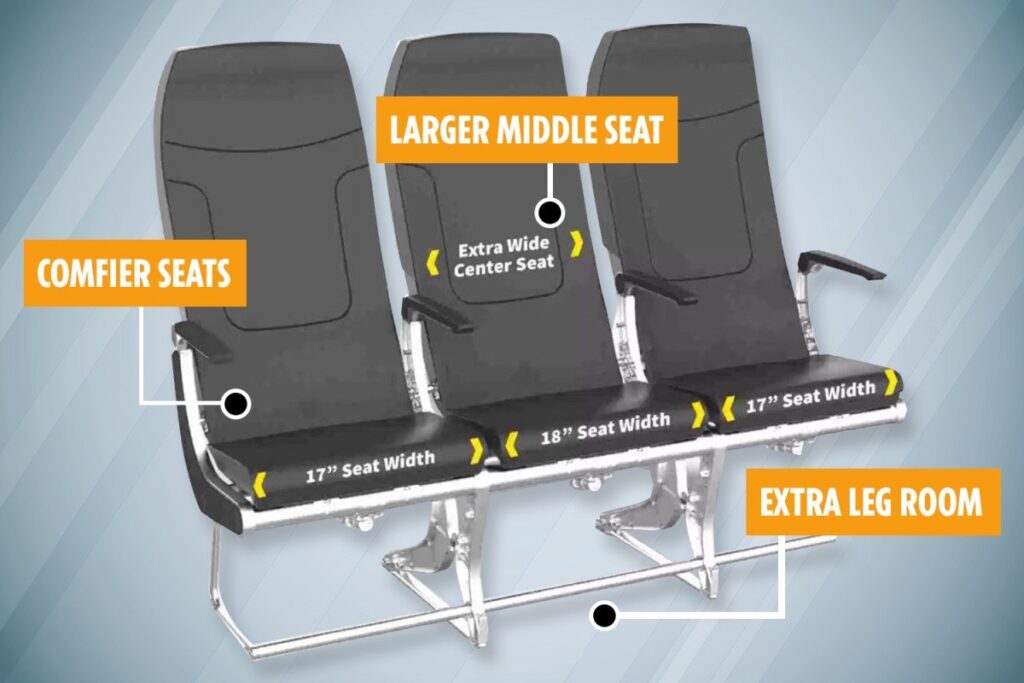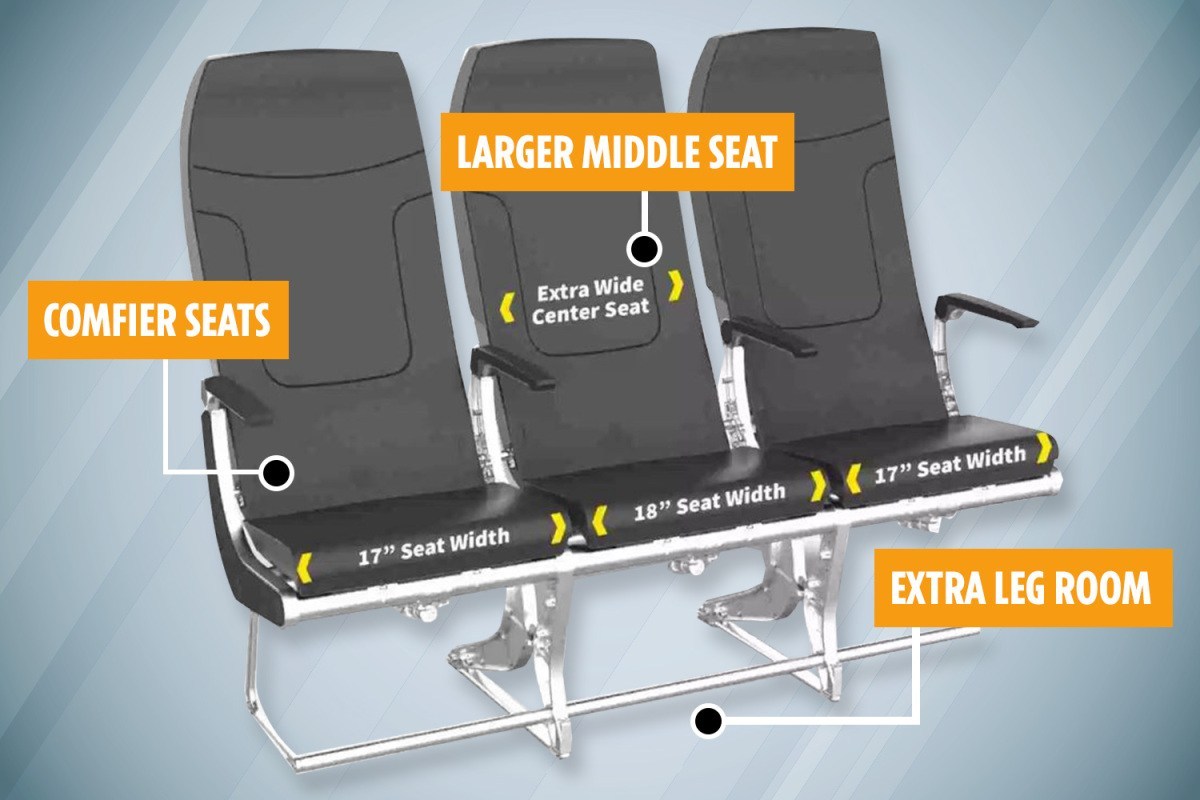More Legroom, More Space, but More Problems on Budget Airlines

Low-cost carriers are notorious for forcing flyers to accept a lower-quality product in exchange for the price. However, two discount airlines want to appear consumer forward in their products. For example, Spirit Airlines is introducing a wider middle seat, while JetBlue has won a survey for the fourth consecutive year on comfort.
What’s the first thing you picture when you think about low-cost carriers? For many flyers, this includes imagery of crowded gates, cramped seats, non-assigned seating and cleaning up the aircraft after yourself. But two low-cost carriers are trying to buck that system, proving their amenities can line up with the major carriers as well.
More Legroom
JetBlue leads this example, after winning the title of “Most Comfortable Airline” by WalletHub for the third consecutive year. The financial website notes JetBlue won for several additional amenities not offered by their competitors, including “Wi-Fi, extra legroom and complimentary snacks and beverages.”
It’s true that JetBlue leads in legroom: According to SeatGuru, the JetBlue Airbus A320 offers up to 34 inches of seat pitch in their main cabin. If you are on an aircraft outfitted with the Mint premium cabin, the pitch reduces to 33 inches, while their Airbus A321 fleet shrinks the pitch down to 32 inches. Despite this, the airline does technically offer more legroom than the legacy carriers, which average around 30 inches between seats, measured from the back of one seat to the upright of the next seat.
More Room in the Middle
At Spirit Airlines, the ultra-low-cost carrier is trying to win back passengers by offering an extra-wide seat to the often neglected middle passenger. The Los Angeles Times reports the airline will begin installing an 18-inch wide seat between two 17-inch wide seats, offering more room for the middle man (or woman). The new seating arrangement will be available on 60 new aircraft and 40 existing fleet aircraft by 2021. The airline did not mention which 40 of their fleet of 135 would receive the new seats.
While it sounds like a consumer win, the carrier isn’t making new space for flyers on either side of the seat bench. Currently, SeatGuru reports Spirit’s Airbus A320 offers 17.75-inch seats in their main cabin. To accommodate the bigger middle seat, the airline will reduce either side seats (window and aisle) to 17 inches. Furthermore, the 18-inch middle seat would put Spirit in line with their legacy competition: Across all the “big three” A320 aircraft, American Airlines’ economy seat ranges between 16.5 and 18 inches of width; Delta Air Lines’ economy seat is consistently 18 inches, while United Airlines’ economy seat is just under 18 inches.
More Problems
While budget airlines advertise slightly more comfortable seats, they may not be the best way to fly. The bit of extra legroom and wider (but still narrower than other airlines) middle seat on a budget airline may end up costing you just as much (or more) than a legacy airline with fewer upcharges. One area where both low-cost carriers suffer is in their on-time arrivals. According to the August 2019 U.S. Department of Transportation Air Travel Consumer Report, Spirit flights arrived on time 71.6 percent of the time, while JetBlue landed on time 70.1 percent of the time. Their on-time record trails Alaska Airlines, Delta, Southwest Airlines and low-cost competitor Allegiant Air.
You may also find that, on budget airlines, cancellations are frequent. One major problem with Spirit is that if your flight is delayed or cancelled your trip delay can wind up being very long (we’ve read reports of up to 12 or 24 hours although it’s rare). But, the news isn’t all bad. Despite its reputation of very poor customer service when it first started flying, budget carrier Spirit can be your best or even most expensive options if you’re aware of the ancillary fees (and you can fit in the seats). And their Big Front Seat is pretty popular.
Despite its reputation for being late, JetBlue is a perennial favorite among very frequent fliers. Check out the FlyerTalk forum on JetBlue to find out everything you need to know.























it amazing how many reporters don't even know what seat pitch is. It is NOT a measure of leg room.
It's true the A320 and 737 have always had the same cabin width per seat, the 737 being set in the mid 20th Century. But the A320 series has a cabin at least a half foot wider than the 737 (and 757). So the there is that much more shoulder room in most any A320 vs 737. Even with the seats the same, the extra shoulder room is a big deal. Most airlines use the extra width for wider seats in the A320. Check it out on your next flights.
Thank you OZFLYER86! Legroom may be decreasing with many airlines, but the effective seat width (i.e., shoulder space) on standard narrow body jets has remained the same for years.
The A320 series has a cabin a half foot or more wider than the 737. So the there is that more more shoulder room in any A320 vs 737. Even with the seats the same, the extra shoulder room is a big deal. Most airline use the extra width for wider seats in the A320.
an A320 cabin width is the same no matter what airline. The only way one airline can have average seat width more than another is to:- 1) reduce armrest width or 2) reduce aisle width & think the latter is regulated. This whole nonsense about seat width has to end. Virtually the only time seat width varies is when some airlines, put 9 across on a A330(instead of 8) or 10 across on a B777(instead of 9) Average seat width hasn't changed on A318/19/20/21 or B737/757 which makes up a huge % of world fleet.